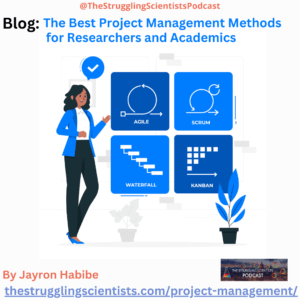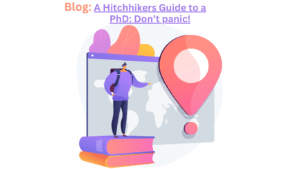Why are you here?
Have you ever just felt like you have so much information to work with and projects to keep track of that it gets overwhelming?
Wait.. You’re a PhD student in academia so of course, you do!
If you’re like me you probably have had to deal with a lot of information at some point throughout your studies or your PhD. I think the biggest problem is that while everyone at some point deals with this issue, no one provides you with a good strategy or framework to address the problem.
Sort of like having a good training schedule for a marathon or a protocol for an experiment you’ve never done before.
I can tell you with some level of certainty that undertaking a difficult running event without any structured training plan is going to lead to problems. The same holds true for managing complex projects or experiments without any structured note-taking. It’s sub-optimal at best and instead of focussing on the content, you find yourself having to focus on how to manage it and keep track of it.
In some cases, you might just forget what you had learned or done over time and might need to either spend hours trying to locate it or restart from scratch as if that first round of learning and doing never happened.
In short, our lives would be a lot easier if we didn’t always have to reinvent the wheel for everything we have to do and keep track of. Well.. what if I told you that there are tools out there that can help you? Imagine never staring at a blank page or re-inventing wheels, or trying to figure out things other people including yourself have already figured out before?
For the longest time during my Master’s and my PhD I had been told to take notes. Notes of the experiments I was performing, the results that came out of them, meeting notes, and notes on my plans for my projects.
It got overwhelming fast because no one had ever given me a good framework for what “good” note-taking looks like. So, instead of producing notes that my future self or other people would be able to use I produced notes that seemed fine in the moment but failed in conveying information to future me weeks or months later when I had moved on to another project.
Now at this point, some of you are probably thinking, well you’re a Master/PhD student shouldn’t you be able to just figure out how to take better notes and manage them?
The answer to this is yes of course yes, however when you consider how much time we spend on everything else it can be hard to actively make time to improve your note-taking, especially while under time pressure to perform.
So given that we all have a ton to do, little time and energy left to do it, and are probably on a budget to get it done what should we do?
How do we rein in control over all the information and the myriad of projects?
Easy… if one brain isn’t enough just get a second one !
What is a Second Brain?
I first came across the concept of a second brain during the third year of my PhD while in lockdown from Covid-19. I was watching a Youtube video from Ali Abdaal on the second brain.
In it, he described this productivity method called a Second Brain which was developed by Tiago Forte. The idea revolves around a system of note-taking that on the surface seems easy because it is.
The Second brain refers to having an external source for keeping all your important notes, thoughts, ideas, quotes, and interesting media in one place.
Once our thoughts, ideas, and notes have been Captured into our second brain we can then proceed to Organising, Distilling, and Expressing our ideas. For an example of this, just think of all the times you had a random idea that you thought was interesting, exciting, or just potentially helpful to you or someone else… and you forgot it and never did anything with it.
If you are like any normal person nowadays you will struggle to keep track of all the information you are bombarded with on a daily basis. Your appointments, ideas, meetings, and inspirations for new projects while all super important and great just take up way too much of your brain space.
One of the things Tiago often says is that “Our brains are made for having ideas, not storing them”. I couldn’t agree more with this statement. This is why many people including myself have gone the route of building digital a second brain.
While paper has been around forever and is great and almost frictionless for use, you will quickly find that it comes with many limitations that we simply do not need to put up with anymore in a digital world. So if you will please allow me to highlight six reasons why you as a PhD student need a digital second brain.

Frees your Brain to have and connect Ideas
The first main benefit of using any external means of storing our notes and ideas is that it frees up our brains from having to remember and we are then able to focus more in-depth on the idea or other ideas. Imagine having to write a book in one go without any external sources to remind you about the details. Odds are it will be a pretty bad book with a lot of inconsistencies.
The same holds true for your project notes and ideas. Writing down the idea in your second brain also gives you the confidence that your great idea or important bit of information is safe and secured where you left it therefore you can proceed with flushing out the idea or even think about something else all together and return to the idea just as you left it.
The most applicable example where this would be handy is when writing a manuscript or your thesis. In either case, you will have to digest a lot of information and produce a coherent story out of it that incorporates not only your findings but that of others as well.
Even if you end up discarding or not using many of the ideas you write down I have found that by writing it down in my second brain I get a better overview of everything I think.
While this may sound obvious at first depending on what tool(s) you use as your second brain you may have features that allow you to view your notes and data in various ways which may provide you with a new perspective or clarity.

The Search Function
Like I said previously, paper is cool and all but I can’t just type in what I’m looking for and immediately have it pop up for me. You may have better paper organizational architecture than I ever did but I hazard a guess that most people don’t and this is where a good second brain shines. Your second brain should have a good search function enabling you to find back important information that you saved either yesterday or years ago.
A great second brain needs this feature because if you use it for long enough you will notice that a lot of information gets buried by newer information and so being able to find that bit of information by just typing a word or two is crucial.
The search function allows for less optimal organization upfront and enables us to easily write down our notes and ideas with the absolute confidence that we will be able to find them back when needed.

No Loss of Information
A digital second brain that is saved on the cloud will be there with my notes and information when I need it. If my computer breaks down I can still access my second brain via my phone or maybe someone else’s computer so I never really lose my information. At most I might have some temporary trouble accessing it but that’s it.
Now contrast this with a notebook or software that is only on your computer. You will lose everything if you lose the notebook or the computer. Having your second brain be on the cloud is invaluable.

Embed Multimedia Content
One of the main benefits of a digital second brain is that you can store multimedia files and snippets on it. Provided you pick a good second brain platform of course.
The ability to simply embed the content or link to it in your second brain afford you the ability to be able to revisit it, double check if what you are saying and thinking is in line with the source, and also refer back to the source.
In many ways this is starting to seem more and more like a reference manager of sorts and to an extent, it is, however, a reference manager is just one of the many ways you can use your second brain but it’s not the only one.
Within your second brain you also dump a ton of multimedia files including videos, PDFs, images, audio files, and various other file formats.
Better Oversight of Projects
Another amazing feature that any good second brain should provide is the ability to have better oversight of your projects. For me, this can come in different forms and it is going to depend on how you prefer to track your progress.
Different ways to track progress can include for example using a kanban board or a Gantt chart. Another way would be the classic progress bar however in most cases that will depend on the type of project or task you have.
I have found that different projects require different tools or ways of viewing progress to have a better overview of exactly how you are progressing. For example, a task in which you simply need to do the same thing X amount of times can easily be conveyed with a progress bar because each unit of progress is the same.
On the other hand, if you have a project that involves doing tasks of different levels of complexity and duration and with asymmetric levels of necessity or reward then it can be much harder to visualize progress using just a progress bar. Maybe in the latter case, a Gantt chart or kanban board is more applicable to you.
Since different projects may require different methods of tracking them, your second brain should be capable of displaying your progress in different views. This customization of project overview is one of the many reasons I use Notion as my second brain.
The best thing about Notion regarding project overview is that you don’t have to sit down beforehand and map out exactly how every step in the project is going to be tracked when designing your overview in Notion. You can instead just start with a database table and add columns that include for example date of completion, the start date of the task, difficulty level, priority level, and even what kind of task it is like a meeting or experiment.
From there if you decide I would like to change up the overview you can then just choose either the timeline view, board view or any of the other options Notion is constantly updating. So overall great tool for project management and I would definitely recommend checking them out as your Second Brain of choice.

Everything gets Easier
This sounds too good to be true but stays with me because it really is the case. I’m not saying it will be easy to get started doing this or that everything afterward will definitely be easy but I am saying that things can be easier than they are right now.
To borrow terminology from the world of investing, “a good investment compounds over time”. The investments you are making by setting up your second brain are several. First off, it will save you time moving forward as you will no longer have to scramble desperately trying to find important files from a year ago. The search function, tagging, and different methods of viewing project progress will help save you time.
Having everything stored is an investment to free up your congition to tackle problems that had previously been difficult if not impossible for you to solve. This is what I mean with everything getting easier. The more time and mental energy you have to aloocate to the problems you want to solve the better or easier the solution you can come up with.
Clarity of mind is invaluable to us as PhD students and having your second brain to house the information helps to clear up the clutter in our first brain and help it run more smoothly.

Conclusion
I hope this article was useful and that you enjoyed reading it as much as I enjoyed writing it.
Let us know what you thought or if you have any life hacks that definitely need to be included.
If you are interested in reading more related and interesting content then check out our blog on the
- Best chrome extensions for PhD students
- or check out our blog on useful mental models.
- You can also check out our blog on Mental health life hacks
- or tips for achieving work-life balance.
Thanks again for reading and we will see you, next time folks!










